It is always best to speak to the breeder you are buying your birds from, they will usually know which birds get along and which don’t. In theory, if given enough space, almost all of the species mentioned in this guide can live together, there will however always be the more aggressive birds and the more passive birds. There are a few species that are usually seen as too aggressive to be kept with other birds.
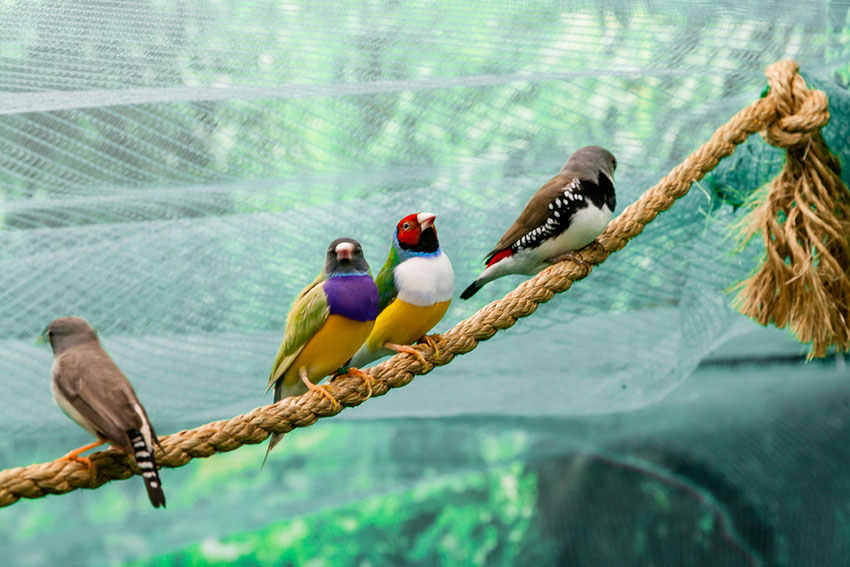
Zebra and Bengalese finches can live together happily, as long as they have plenty of room
The general rule is to keep pushy birds with other pushy birds, timid birds with other timid birds and so on. Use the guide below as a general guide on which birds should get along fine, though always double check with the person who is supplying your birds.
- In general the following birds can live othetterh with little to no problems: Gouldian Finch, Double-Barred (or Owl) finch, Bengalese (Society) finch, Plum-headed finch, Red-headed Parrot Finch, Chestnut and Scaly-Breasted Munia.
- The Star Finch needs extra space and cover due to its timid nature. They will be happier if kept in flocks of their own kind.
- Canaries need large aviaries to be able to coexist with other species. In general they are happier on their own or in pairs.
- The following can live together if given enough space, but look out for the bullies: Zebra Finch, Java Sparrow, Strawberry Finch, Lavender Waxbill.
- The real bullies of the finch world are the Diamond Firetail and the Cut-Throat Finch.
Keeping a single Finch
Finches will not be happy or healthy if kept alone. The one species that can be kept alone is the Canary. All other species of Finch will need to be kept in at least pairs. Infact, keeping finches in pairs is the ideal setup for many owners, as it does not require a large cage and as a result saves on space. This being said, there are some species that will only truly thrive in a flock.
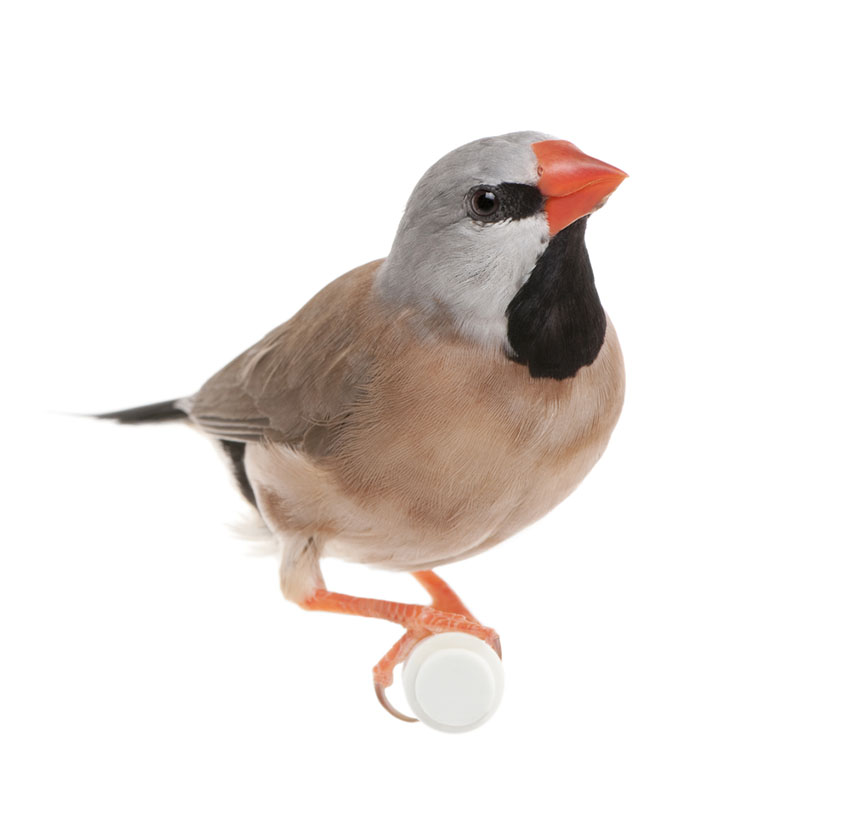
This Black-throated finch doesn't want to be alone!
Keeping Males or Females Together
Finches are best kept in Male-Female pairs. Single birds are fine in a larger flock of at least 3 pairs and juveniles will happily perch and feed together right up until the hormones kick in (around 9 weeks old). It is at this point that same sex pairs will begin to fight of they are being kept togther with no other birds.
Any unpaired birds will opt to live alone rather than with the other unpaired birds. In some cases cock birds can cause problems when they try to court a female who has already chosen her mate. Zebra Finches and many other species only have one partner at a time, so the not-so-lucky birds will have a long wait ahead of them unless some new additions to the aviary turn up.
Keeping Canaries with Other Birds
Canaries are kind and easy going birds. Birds kept in Male-Male or Female-Female pairs, just like the other finches, will squabble but pretty much any other combination is fine. For example, several males should be able to coexist without being at one another's throats all the time. The easy-going nature of these birds makes them good mixers, they are unlikely to intimidate any other species.
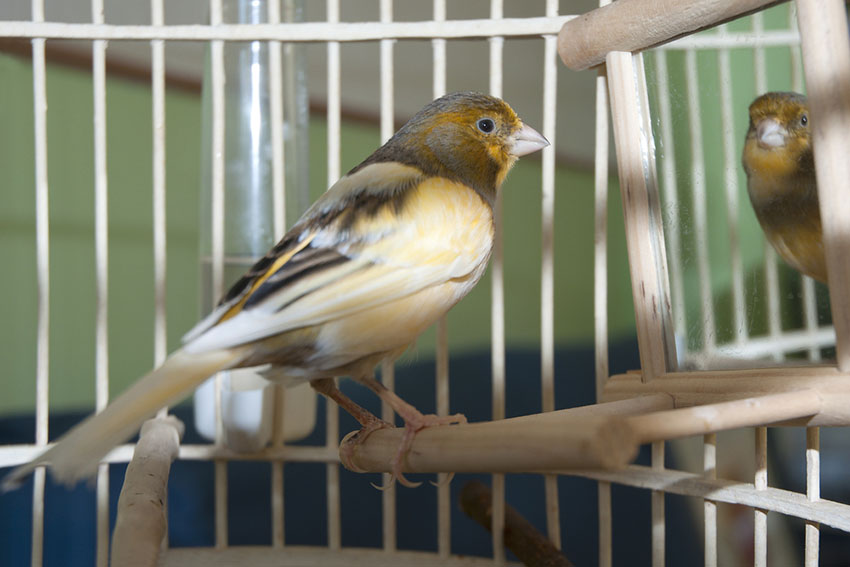
Although Canaries prefer their own company, they can still thrive in a mixed aviary
However, even with all this being said, it is important to remember that there are two sides to the coin. Problems with Canary cohabitation seemingly always come from the other species. More aggressive species will pick on a less aggressive bird like a Canary. Also, a mixed aviary will be detrimental to the bird’s breeding prospects, as they need their peace and quiet to be able to fledge their young.
There are two factors that come into play when trying to establish a peaceful and harmonious community of birds - space and species. In large aviaries, the bullies and the victims will be able to stay out of one another's way- the dominant bird will be able to keep other birds away simply with body language. Be sure to keep at least two feeding stations, as a dominant bird may try to claim one as his own and not let other birds near. You will also have to provide plenty of perches and space to roost high up in the cages. Birds will fight over who gets the top perches, so having lots of them helps ease the tension of settling-down for the night.
As the bird keeper, it is up to you to examine and control the behaviour of your birds. Of course the occasional peck or half-hearted chase around the aviary is nothing to worry about, but if these actions become persistent and prolonged you will need to intervene by isolating the bully.
Canaries and Other Finches
Of all the Finches mentioned in this guide, the most easy going ones are Canaries, the Star Finch and the Bengalese Finch. Whilst the Zebra Finch seems to be the obvious choice thanks to its widespread availability and popularity, this species is on the more aggressive side of things and you will need a large cage if you plan on mixing Zebra Finches with other Finches.
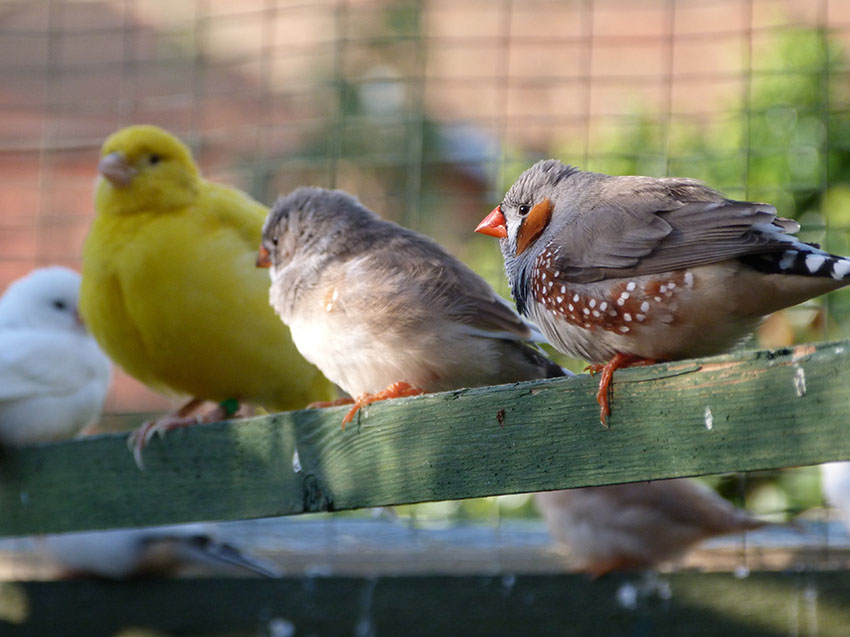
Canaries and Zebra finches can only live together if there's lots of space
Even if you have a mix of docile birds, they still need their space and the cage should be no less than 45 inches in width, preferably more. In a cage like this you will be able to house the following finches together: Canaries, Bengalese, Star, Gouldian, Double-Barred and Plum-Headed, Chestnut Munias and Parrot Finches.
Canaries and Budgies
These are, along with the Zebra Finch, the most popular cage birds, so it comes as no surprise that people have tried keeping the two together. If you do plan on keeping the two species together, you’ll need a cage which is at least 30ft in width.
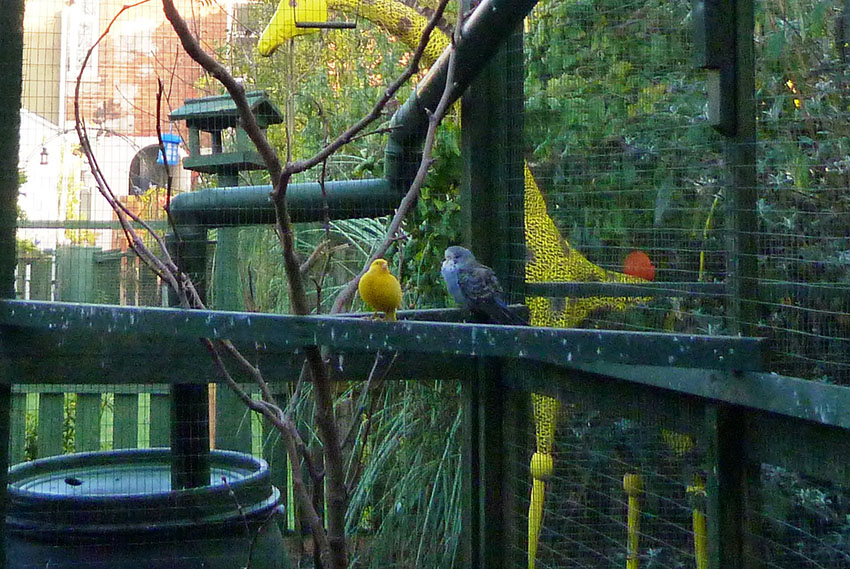
Canaries and budgies need lots of space, including separate feeding and roosting areas
Budgies don’t have a problem with canaries and most of the time will leave them be, yet they will still defend their perch or feeding station with a peck - budgies have a relatively powerful peck alongside a hooked beak - which can cause a lot of damage to a fragile bird such as the Canary. Budgies and other parrots also have the tendency to peck at other bird’s legs and they could easily snap the leg of a canary or other finch.
This setup can work if approached correctly. You may even see other aviares with even more risky finch cohabitees such as cockatiels, parakeets and lorikeets. These types of setups only work in very large aviaries, the types you find in parks or zoos. Anything smaller than 30ft in width is not large enough for you to be mixing finches with parrots.
Keeping Zebra Finches and Budgies Together
As mentioned above, Canaries, Zebra Finches and Budgerigars are the three most popular cage birds throughout the world. Because of this one would assume that they will all get on well together. Zebra Finches, being more confident in themselves, actually fare a lot better with Budgies than the Canary does and in an aviary or bird house the two species will go about their days seemingly without noticing one another.Again, be sure to provide enough space in your cage or aviary.
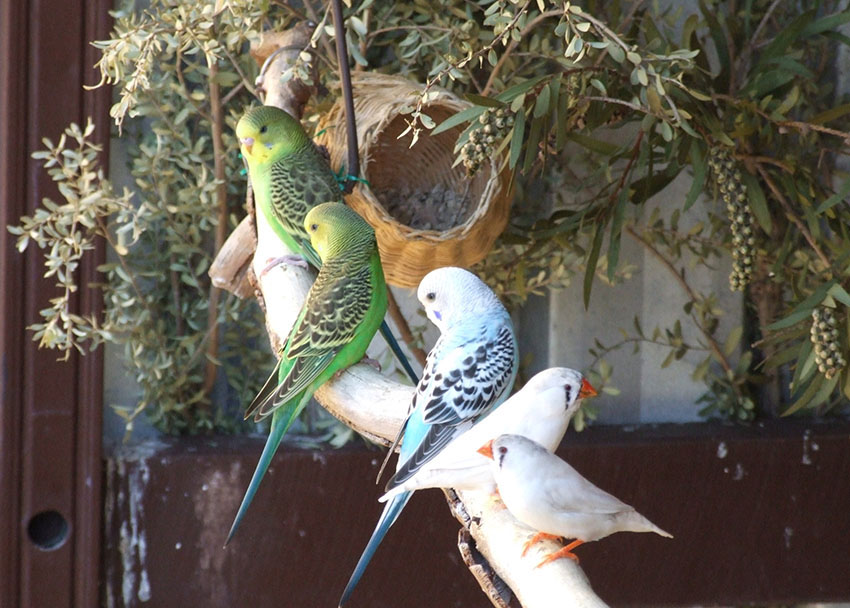
Zebra Finches and Budgies, both natives of Australia, thrive together in a large, mixed aviary
Keeping Finches and Quail Together
Seeing Quail in mixed aviaries is not an uncommon sight. If you’re keeping your birds outside, then finches should have no problem with quail. It helps that the quail is a ground bird, as they take little notice of the finch world above them. Some of the most popular types of quail are the tiny Chinese Painted Quail (also known as the button quail or King quail) asn the Japanese Quail.
Keeping Finches and Doves Together
Doves are not usually kept in mixed aviaries. Some keepers mix them in with their finches and parakeets, though, and they are placid - and large - enough to thrive in most aviary setups without causing problems for their cage-mates.
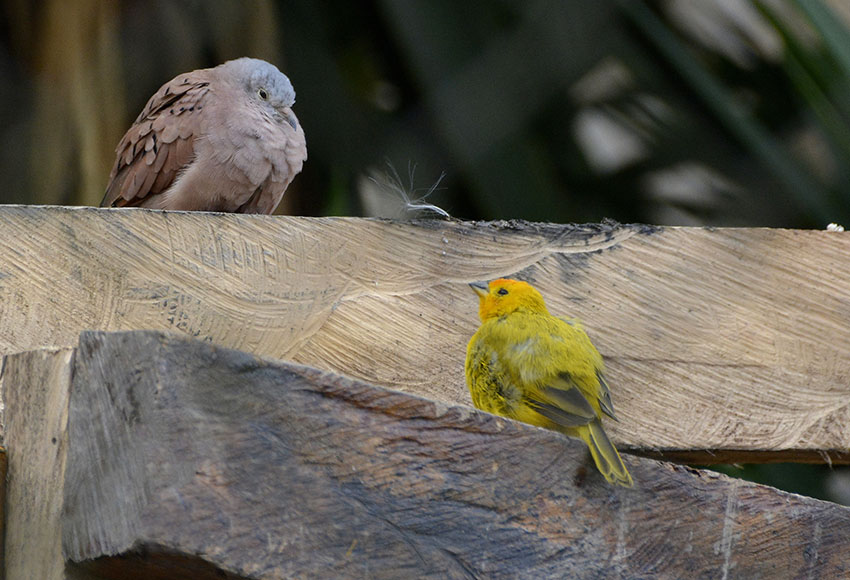
Finches and doves mix well in an aviary, each respectfully ignoring the other
Common dove species in the pet trade include the Ring-necked dove (Streptopelia capicola) and the Diamond dove (Geopelia cuneata). The latter bird is popular due to its tiny size (by pigeon standards) of 8 inches, whereas the Ring-necked is a sleek but substantial 12 inches. Both birds (like all members of the pigeon family) need plenty of grain in their diets, so a standard finch or parakeet mix will not provide them with what they need.


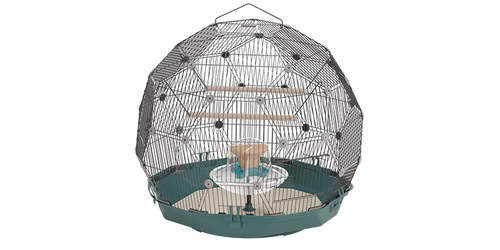
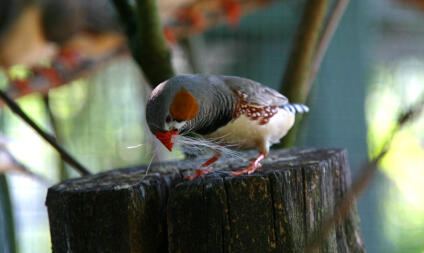
Comments
Larry, 17 August 2024
Can you have two male canaries in same cage? My cage is about 23” wide. Also do Goulans usually stay low in the cage?
Gail, 6 April 2024
I have budgies and a canary. My canary desperately wants to cohabitate with the budgies; but, unfortunately i've found my canary with an injuried bleeding leg causing him pain on several occasions and have even seen one of the budgies chase him. This does not seem to deter the canary as whenever he can access the budgies he tries despite having been injurred by them. I let them fly free; but, now keep them in seperate rooms.
Phillip, 16 October 2022
I have a fife canary who got along very well with my old fifes that died. She is in a good sized cage for her size, and I was wondering if I could keep a budgie with her or not? Every article I've seen pretty much says to do it at your own risk, but I would like a definitive answer from someone more experienced than wikihow. The cage is 3 feet across, 2 1/2 back, and 3 feet tall. I would be able to take the budgie out every day and would have seperate waters and foods for them both. TL;DR can I keep a budgie with a passive but friendly canary?
Nathan, 2 March 2022
I am just wondering what birds can live together as I have button quail. Zebra finches, lovebirds, budgies, cockatiels. What out of them can be in a large avairy please
Cherry, 7 February 2022
Sorry - just to clarify: the Bengalese is the English (UK) name for the finch that is referred to as the Society in some other parts of the English speaking world! The biological name of the bird I am referring to is Lonchura striata domestica, though it is not always regarded as a full subspecies and is sometimes listed simply as Lonchura striata.